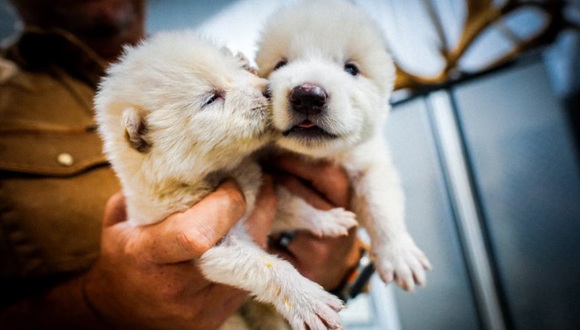For more than a decade, scientists have been pursuing the idea of reviving extinct species, a process sometimes called «de-extinction». Now, a company called Colossal Biosciences seems to have succeeded, or something close to it, with the dire wolf, a giant extinct species made famous by the TV series Game of Thrones.
In 2021, an independent team of scientists managed to recover DNA from fossils of giant (or dire) wolves, extinct some 13 000 years ago. With the discovery of additional DNA, the Colossal researchers edited 20 grey wolf genes to endow the animals with key characteristics of giant wolves. They then created embryos from the edited grey wolf cells, implanted them into surrogate mothers and waited for them to give birth.
The result is three healthy wolves: two 6-month-old males and a 2-month-old female, named Romulus, Remus and Khaleesi, who have some of the traits of giant wolves. They are large, for example, and have a dense, pale coat not found in grey wolves. Colossal, valued at $10 billion in January, keeps the wolves in a private facility at an undisclosed location in the northern United States.
Beth Shapiro, Colossal’s chief scientific officer, described the wolf pups as the first successful case of de-extinction. «We’re creating functional copies of something that used to be alive,» she said in an interview.
The animals will remain in captivity. But the technology the company has developed could help conserve species that are not yet extinct, such as the critically endangered red wolf, whose population is mainly confined to North Carolina.
In 2022, red wolf-coyote hybrids were discovered in Texas and Louisiana. On Monday, Colossal also announced the production of four clones from these hybrids. Hypothetically, the introduction of these clones in North Carolina could improve the genetic diversity of the area’s red wolf population and help the species avoid extinction.
Over the years, scientists have proposed various ways to revive an extinct species. Suppose, for example, they recover an intact cell from the frozen carcass of a woolly mammoth. Perhaps the cell could be thawed and used to create a mammoth clone.
The entrepreneurs and scientists who founded Colossal in 2021 took a different path. They would analyse ancient DNA to identify key mutations that differentiated extinct species from their living relatives. The researchers would then modify the DNA of a living relative and use those genes to produce viable animals. The revived animals would not be genetically identical to the extinct species, but they would be identical in crucial respects.
Colossal began high-profile experiments with woolly mammoths and the dodo, a flightless bird that became extinct three centuries ago. Then came the challenges.
First, while it is relatively easy to make a single edit to an animal’s DNA, scientists expected to make dozens of edits. Then there was the question of producing animals from edited DNA. The Colossal researchers envisioned developing mammoth foetuses into Asian elephant surrogate mothers, but no one had ever performed in vitro fertilisation on elephants. To resuscitate a dodo, they would have to somehow manipulate a modified bird embryo into a hard-shelled egg.
In 2023, the Colossal team began to focus on giant wolves as a potentially easier species to achieve. Giant wolves are related to dogs, so scientists could build on years of research into cloning dogs and implanting canine embryos.
«We’ve done a lot of work with dogs, because people love everyone’s favourite domestic grey wolf,» Dr Shapiro said.
Shapiro, who joined Colossal in 2024, was part of the team that first recovered direwolf DNA from fossils in 2021. However, that work recovered only trace genetic material. At Colossal, she and her colleagues decided to search for more direwolf DNA in the hope of better understanding the biology of the extinct species and, perhaps, reviving the animal.
«It was the easiest way to get a predictable result,» Shapiro said.
The team combed through giant wolf fossils using new methods to isolate DNA. This time, they hit the nail on the head: they discovered a wealth of genetic material in two fossils: a 13 000-year-old tooth found in Ohio and a 72 000-year-old skull found in Idaho. The giant wolf genomes allowed Shapiro and his colleagues to reconstruct the history of these animals in greater detail.
The giant wolves turned out to belong to the same lineage that gave rise to today’s African wolves, jackals and wild dogs. The giant wolf diverged from the main branch about 4.5 million years ago. Later, about 2.6 million years ago, they interbred with other species, including the ancestors of today’s grey wolves and coyotes.
Giant wolves dominated southern Canada and the United States, according to Julie Meachen, a Des Moines University paleontologist who worked on the ancient DNA project. And they outcompeted grey wolves, being 25 per cent larger with huge teeth and jaws. They hunted horses, bison and possibly mammoths. When many of these prey species became extinct, probably in part due to human hunting, the giant wolf may have been doomed to extinction, and the grey wolf spread from northern Canada and Alaska to fill the ecological gap.
Meachen and his colleagues discovered that giant wolves and grey wolves are more than 99% genetically identical. Eighty genes were radically different; some are known to influence the size of today’s dogs and wolves, suggesting that they were responsible for the large size of giant wolves.
More surprising was the discovery that giant wolves carried genes for a light coat, and that the fur was probably thick and dense. Dr Shapiro and her colleagues are preparing a paper describing these results.
Recipe for a giant wolf
With a list of giant wolf genes in hand, the Colossal scientists began their de-extinction project.
First, they isolated blood cells from grey wolves and cultured them in a dish. There, they modified the wolf’s DNA.
Ten years ago, the scientists altered a single gene in beagles to give them large muscles. Since then, researchers have learned to edit several genes at once in the mammals’ DNA. For the direwolf project, the Colossal team set out to edit 20 genes, pushing the technology to its limits.
The scientists introduced the giant wolf’s own mutations into 15 genes. However, they did not introduce the remaining five, as previous studies had shown that these five mutations cause deafness and blindness in grey wolves.
So the Colossal team found mutations in those five genes present in dogs and grey wolves without causing disease. They introduced these five back-up mutations into the grey wolf cells.
«It’s a fine line,» Shapiro said. «You’re looking to resurrect these phenotypes, but you don’t want to do something that’s detrimental to the animal.»
The researchers transferred edited DNA from grey wolf blood cells into an empty dog egg. They created dozens of these eggs, which they implanted into large dogs that served as surrogate mothers.
Most of the embryos did not develop, but four pups were born. One died from a ruptured intestine after 10 days, but an autopsy showed that the death was not due to a harmful mutation.
Matt James, director of animals at Colossal, supervised the pregnancies and births. He knew the experiments were a success as soon as he saw the white fur of a puppy.
That first flash of white was a real slap in the face,» James said. «It will stick with me forever.»
Two of the puppies, Romulus and Remus, are named after the mythical founders of Rome, who were raised by a she-wolf. The third puppy, Khaleesi, is named after a major character from Game of Thrones.
James stated that the wolves were approximately 20% larger than grey wolves of their age. Not only is their fur white and thick, but they also sport unusually bushy tails and a mane around their necks.
Researchers are waiting to see how big the wolves grow and are watching for any unexpected changes in their biology. «I’m fascinated to see what happens,» Shapiro said.
He added that the animals were unlikely to reveal much about the giant wolves’ behaviour, given their captive breeding.
«I would love to know the natural behaviour of a giant wolf,» he said. «But, in essence, they live like a wolf in a luxury hotel. They can’t get a splinter without us knowing about it.»
Adam Boyko, a geneticist at Cornell University who was not involved in the project, commented, «It’s exciting to be able to create functional versions of extinct species.» However, he did not consider Romulus, Remus and Khaleesi to be truly resurrected giant wolves. They do not breed in direwolf packs, where they could learn their behaviour, Boyko said. And they do not consume an ancestral diet, so they do not acquire the unique set of gut microbes of their ancestors.
The animals carry 20 giant wolf genes, which could reveal something about the biology of the extinct species. But Boyko speculated that many other genes also contributed to differentiating them from other wolves. «We don’t know that number,» he said. «It could be 20, or 2,000.»
Colossal has been collaborating with several American Indian communities in the United States. The MHA Nation of North Dakota has expressed interest in the direwolf project. «Their presence would remind us of our responsibility as stewards of the Earth,» Mark Fox, tribal chairman of the MHA Nation, said in a statement released by the company.
But if animals with direwolf DNA were introduced into the wild, they would have to survive in a world radically different from that of the ice age. The huge animals that direwolves specialised in hunting are either extinct or survive in small populations. Any direwolves that were resurrected and roaming freely would have to resort to smaller prey and potentially compete with the grey wolves.
Grey and red wolves, meanwhile, face threats, including hunting, that no genetic magic can address.
Last month, 60 environmental organisations protested a bill before Congress that would remove grey wolves from the endangered species list, a change that could lead to more hunting deaths, the groups warned.
«If signed into law, the bill would actually sign death sentences for thousands of wolves across the country,» they wrote.
Meachen, who was not involved in the creation of the wolf cubs, said he had mixed feelings about the de-extinction effort.
«All my childlike sensibilities tell me I want to see what they look like,» he said. «But I have questions. We have problems with the wolves we have today.»
(With information from The New York Times)




